Annual Statistical Report on the Social Security Disability Insurance Program, 2007
Beneficiaries in Current-Payment Status
In December 2007, over 8.1 million people received Social Security disability benefits as disabled workers, disabled widow(er)s, or disabled adult children. The majority (87 percent) were disabled workers, 10 percent were disabled adult children, and 3 percent were disabled widow(er)s.
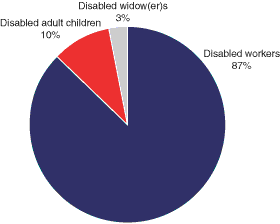
The number of disabled workers grew steadily until 1978, declined slightly until 1983, started to increase again in 1984, and began to increase more rapidly beginning in 1990. The growth in the 1980s and 1990s was the result of demographic changes, a recession, and legislative changes. The number of disabled adult children has grown slightly, and the number of disabled widow(er)s has remained fairly level. In December 2007, about 7.1 million disabled workers, nearly 795,000 disabled adult children, and nearly 225,000 disabled widow(er)s received disability benefits.
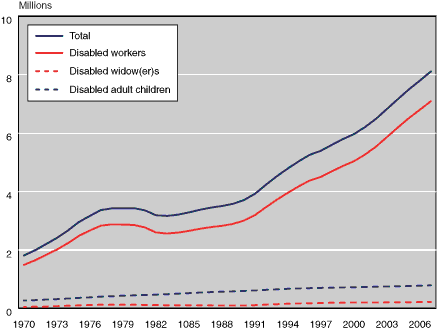
| Year | Total | Disabled workers | Disabled widow(er)s | Disabled adult children |
|---|---|---|---|---|
| 1970 | 1.81 | 1.49 | 0.05 | 0.27 |
| 1971 | 1.99 | 1.65 | 0.06 | 0.29 |
| 1972 | 2.20 | 1.83 | 0.06 | 0.31 |
| 1973 | 2.42 | 2.02 | 0.08 | 0.32 |
| 1974 | 2.67 | 2.24 | 0.09 | 0.34 |
| 1975 | 2.96 | 2.49 | 0.11 | 0.36 |
| 1976 | 3.17 | 2.67 | 0.12 | 0.38 |
| 1977 | 3.37 | 2.84 | 0.13 | 0.40 |
| 1978 | 3.43 | 2.88 | 0.13 | 0.42 |
| 1979 | 3.44 | 2.87 | 0.13 | 0.44 |
| 1980 | 3.44 | 2.86 | 0.13 | 0.45 |
| 1981 | 3.36 | 2.78 | 0.12 | 0.46 |
| 1982 | 3.19 | 2.60 | 0.12 | 0.47 |
| 1983 | 3.17 | 2.57 | 0.11 | 0.49 |
| 1984 | 3.21 | 2.60 | 0.11 | 0.51 |
| 1985 | 3.29 | 2.66 | 0.11 | 0.53 |
| 1986 | 3.38 | 2.73 | 0.11 | 0.55 |
| 1987 | 3.45 | 2.79 | 0.11 | 0.56 |
| 1988 | 3.51 | 2.83 | 0.10 | 0.57 |
| 1989 | 3.58 | 2.90 | 0.10 | 0.59 |
| 1990 | 3.71 | 3.01 | 0.10 | 0.60 |
| 1991 | 3.93 | 3.19 | 0.11 | 0.62 |
| 1992 | 4.24 | 3.47 | 0.13 | 0.64 |
| 1993 | 4.53 | 3.73 | 0.15 | 0.66 |
| 1994 | 4.80 | 3.96 | 0.16 | 0.67 |
| 1995 | 5.04 | 4.19 | 0.17 | 0.69 |
| 1996 | 5.26 | 4.39 | 0.18 | 0.70 |
| 1997 | 5.40 | 4.51 | 0.19 | 0.70 |
| 1998 | 5.61 | 4.70 | 0.19 | 0.71 |
| 1999 | 5.80 | 4.88 | 0.20 | 0.72 |
| 2000 | 5.97 | 5.04 | 0.20 | 0.73 |
| 2001 | 6.21 | 5.27 | 0.20 | 0.74 |
| 2002 | 6.49 | 5.54 | 0.21 | 0.74 |
| 2003 | 6.83 | 5.87 | 0.21 | 0.75 |
| 2004 | 7.17 | 6.20 | 0.21 | 0.76 |
| 2005 | 7.50 | 6.52 | 0.22 | 0.77 |
| 2006 | 7.80 | 6.81 | 0.22 | 0.78 |
| 2007 | 8.12 | 7.10 | 0.22 | 0.79 |
Disabled beneficiaries aged 18–64 in current-payment status accounted for about 4.0 percent of the population aged 18–64 in the United States. In 6 states and the District of Columbia, they represented less than 3 percent of the state population. The states with the highest rates of disabled beneficiaries—5 percent or more—were Alabama, Arkansas, Kentucky, Louisiana, Maine, Mississippi, Missouri, North Carolina, Oklahoma, South Carolina, Tennessee, and West Virginia.
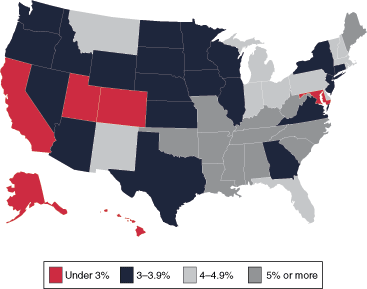
| State | Percent |
|---|---|
| United States | 4.0 |
| Alabama | 7.1 |
| Alaska | 2.5 |
| Arizona | 3.6 |
| Arkansas | 7.2 |
| California | 2.8 |
| Colorado | 2.7 |
| Connecticut | 3.5 |
| Delaware | 4.5 |
| District of Columbia | 2.9 |
| Florida | 4.0 |
| Georgia | 3.8 |
| Hawaii | 2.7 |
| Idaho | 3.8 |
| Illinois | 3.3 |
| Indiana | 4.3 |
| Iowa | 3.8 |
| Kansas | 3.7 |
| Kentucky | 7.1 |
| Louisiana | 5.2 |
| Maine | 6.5 |
| Maryland | 3.0 |
| Massachusetts | 4.4 |
| Michigan | 4.6 |
| Minnesota | 3.3 |
| Mississippi | 7.0 |
| Missouri | 5.2 |
| Montana | 4.0 |
| Nebraska | 3.5 |
| Nevada | 3.1 |
| New Hampshire | 4.5 |
| New Jersey | 3.3 |
| New Mexico | 4.5 |
| New York | 3.9 |
| North Carolina | 5.1 |
| North Dakota | 3.4 |
| Ohio | 4.1 |
| Oklahoma | 5.0 |
| Oregon | 3.7 |
| Pennsylvania | 4.6 |
| Rhode Island | 4.9 |
| South Carolina | 5.5 |
| South Dakota | 3.5 |
| Tennessee | 5.6 |
| Texas | 3.2 |
| Utah | 2.4 |
| Vermont | 4.8 |
| Virginia | 3.9 |
| Washington | 3.5 |
| West Virginia | 8.4 |
| Wisconsin | 3.8 |
| Wyoming | 3.3 |
The percentage of disabled-worker beneficiaries increases with age for both men and women. In December 2007, the largest percentage of disabled-worker beneficiaries was aged 60–64. Disability benefits convert to retirement benefits when the worker reaches full retirement age, 65–67, depending on the year of birth.
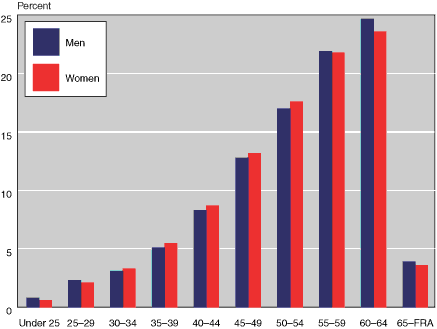
| Age | Men | Women |
|---|---|---|
| Under 25 | 0.8 | 0.6 |
| 25–29 | 2.3 | 2.1 |
| 30–34 | 3.1 | 3.3 |
| 35–39 | 5.1 | 5.5 |
| 40–44 | 8.3 | 8.7 |
| 45–49 | 12.8 | 13.2 |
| 50–54 | 17.0 | 17.6 |
| 55–59 | 21.9 | 21.8 |
| 60–64 | 24.7 | 23.6 |
| 65–FRA | 3.9 | 3.6 |
The average monthly benefit for disabled-worker beneficiaries is higher than that paid to disabled widow(er)s or disabled adult children. The reason for the difference is that disabled workers receive 100 percent of the primary insurance amount (PIA), compared with 71.5 percent for disabled widow(er)s and 50 percent for disabled adult children (if the worker is disabled or retired) or 75 percent (if the worker is deceased).
Because men have traditionally had higher earnings than women, their monthly benefit is higher. This is most obvious in the disabled-worker group. Benefits for disabled widow(er)s and disabled adult children are dependents' benefits, so their monthly benefit is a function of the worker's earnings. Therefore, a disabled widow's average benefit tends to be higher than that of a disabled widower because a male worker's earnings are higher than a female worker's. Benefit amounts are about the same for men and women in the disabled adult children group.
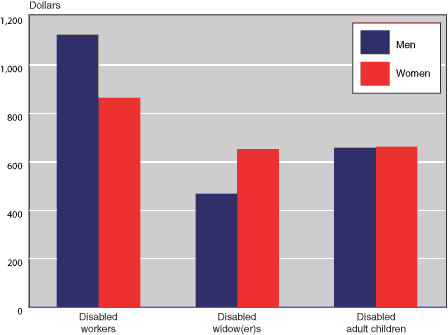
| Beneficiary | Men | Women |
|---|---|---|
| Disabled workers | 1,125.9 | 865.6 |
| Disabled widow(er)s | 468.8 | 652.7 |
| Disabled adult children | 658.0 | 663.2 |
The impairment on which disability is based varies with the type of beneficiary. In December 2007, a mental disorder other than retardation was the primary reason disabled workers received benefits; diseases of the musculoskeletal system and connective tissue were the leading cause of disability among disabled widow(er)s; and mental retardation was the predominant reason for disability among disabled adult children.
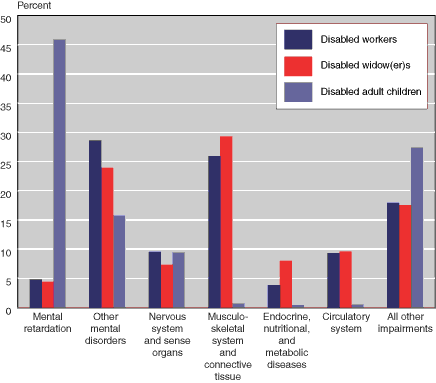
| Diagnostic group | Disabled workers |
Disabled widow(er)s |
Disabled adult children |
|---|---|---|---|
| Mental retardation | 4.8 | 4.3 | 46.2 |
| Other mental disorders | 28.6 | 24.4 | 16.6 |
| Nervous system and sense organs | 9.5 | 7.3 | 9.6 |
| Musculoskeletal system and connective tissue | 26.4 | 29.9 | 0.7 |
| Endocrine, nutritional, and metabolic diseases | 3.7 | 7.7 | 0.4 |
| Circulatory system | 9.2 | 9.3 | 0.5 |
| All other impairments | 17.8 | 17.1 | 25.9 |